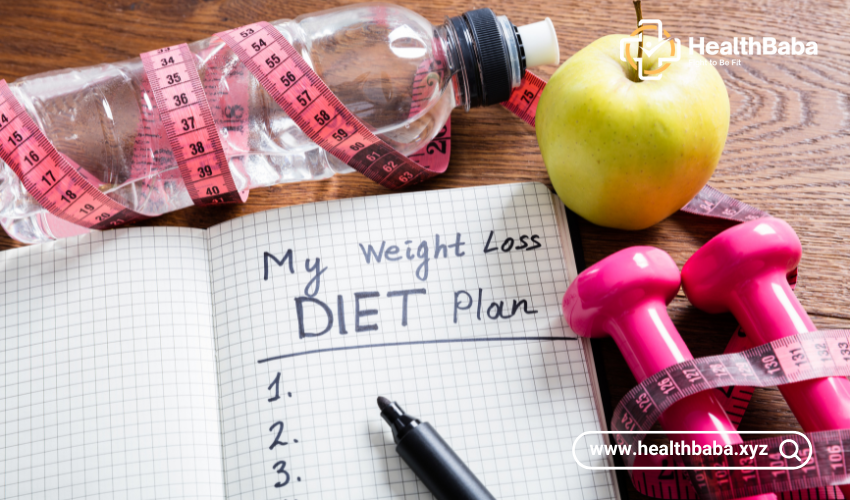The ultimate weight loss plan is a combination of a structured diet program, such as the Mayo Clinic Diet, and regular exercise. The Mayo Clinic Diet, developed by experts at the Mayo Clinic, is based on research and clinical experience.
It focuses on healthy eating and lifestyle changes for long-term weight loss success. Regular exercise helps burn off excess calories, boosts mood, strengthens cardiovascular health, and reduces blood pressure.
Understanding The Fundamentals Of Weight Loss
How Weight Loss Works: Calories In Vs Calories Out
Weight loss essentially comes down to a simple equation: calories in versus calories out. To shed those extra pounds, you need to consume fewer calories than your body burns on a daily basis. This creates a calorie deficit, forcing your body to tap into its fat stores for energy. When you consistently maintain a calorie deficit, you’ll start losing weight.
The Role Of Diet In Weight Loss
Diet plays a crucial role in weight loss. The food choices you make can either help or hinder your progress. It’s important to focus on a balanced and nutritious diet that includes a variety of fruits, vegetables, lean proteins, whole grains, and healthy fats. Additionally, reducing your intake of processed foods, sugary snacks, and high-calorie beverages can significantly contribute to weight loss.
The Importance Of Exercise For Burning Calories And Boosting Metabolism
Regular exercise is not only beneficial for overall health but also plays a pivotal role in weight loss. Engaging in physical activity helps burn calories, thus aiding in creating a calorie deficit. Furthermore, exercise boosts your metabolism, allowing you to burn more calories even at rest. Aim for a combination of cardiovascular exercises, such as running or swimming, and strength training exercises, like weightlifting, to maximize calorie burn and increase muscle mass.
Creating A Balanced And Nutritious Meal Plan
When it comes to achieving weight loss goals, creating a balanced and nutritious meal plan is essential. A meal plan that incorporates all essential nutrients not only supports your body’s overall health but also aids in sustainable weight loss. In this article, we will explore the key components of designing a meal plan that promotes weight loss while ensuring optimal nutrition.
Designing A Meal Plan That Incorporates All Essential Nutrients
To create a meal plan that incorporates all essential nutrients, it is important to focus on a variety of food groups. Here is a breakdown of the different food groups and the nutrients they provide:
- Fruits and vegetables: These should form the foundation of your meal plan. They are rich in essential vitamins, minerals, and fiber that help support weight loss and overall health.
- Lean proteins: Including lean proteins, such as skinless chicken, fish, tofu, or legumes, helps keep you feeling satisfied and aids in muscle growth and repair.
- Healthy fats: Incorporating sources of healthy fats, such as avocados, nuts, and olive oil, provides essential nutrients and helps keep you feeling full and satisfied.
- Whole grains: Choosing whole grains, such as quinoa, brown rice, and whole wheat bread, provides fiber and sustained energy throughout the day.
- Dairy or dairy alternatives: Including low-fat dairy or dairy alternatives, like almond milk or Greek yogurt, provides calcium and other essential nutrients.
By including a variety of these food groups in your meal plan, you can ensure that you are getting all the essential nutrients your body needs for optimal functioning.
Emphasizing Portion Control To Manage Calorie Intake
Portion control plays a crucial role in managing calorie intake and achieving weight loss goals. Here are some tips for practicing portion control:
- Use smaller plates and bowls to control portion sizes.
- Pay attention to hunger and fullness cues, eating until you feel satisfied rather than overly full.
- Measure out servings of proteins and grains to ensure you are not consuming more than needed.
- Include a variety of colorful fruits and vegetables, as they tend to be lower in calories and higher in nutrients.
By practicing portion control, you can enjoy a variety of foods while still managing your calorie intake and promoting weight loss.
Including A Variety Of Fruits, Vegetables, Lean Proteins, And Healthy Fats
To create a balanced and nutritious meal plan, it is important to include a variety of fruits, vegetables, lean proteins, and healthy fats. Here is a sample meal plan that adheres to these principles:
| Meal | Food |
|---|---|
| Breakfast | Spinach omelet with cherry tomatoes and feta cheese, served with whole wheat toast |
| Lunch | Grilled chicken salad with mixed greens, cucumber, avocado, and a light vinaigrette dressing |
| Snack | Greek yogurt with berries and a sprinkle of chia seeds |
| Dinner | Baked salmon with quinoa and steamed broccoli |
| Snack | Apple slices with almond butter |
This sample meal plan includes a balance of fruits, vegetables, lean proteins, and healthy fats, ensuring you receive a wide range of nutrients while promoting weight loss.
In conclusion, creating a balanced and nutritious meal plan is essential for achieving sustainable weight loss. By designing a meal plan that incorporates all essential nutrients, emphasizing portion control, and including a variety of fruits, vegetables, lean proteins, and healthy fats, you can support your weight loss journey while nourishing your body.
Incorporating Physical Activity For Faster Results
Physical activity plays a crucial role in any weight loss journey. Not only does it help burn off excess calories that cannot be cut through diet alone, but exercising regularly also offers numerous health benefits. This includes boosting your mood, strengthening your cardiovascular system, and reducing your blood pressure. In this section, we will explore the benefits of regular physical activity for weight loss, the types of exercises that are effective for burning calories and boosting metabolism, and how to create a sustainable exercise routine that fits your lifestyle.
The Benefits Of Regular Physical Activity For Weight Loss
Regular physical activity is essential for achieving your weight loss goals. Here are some of the key benefits that exercising provides:
- Calorie burning: Engaging in physical activity helps burn calories, assisting in creating a calorie deficit necessary for weight loss.
- Boosts metabolism: Exercise can increase your metabolic rate, allowing you to burn more calories even at rest.
- Muscle development: Incorporating strength training exercises helps build lean muscle mass, which can further enhance your metabolism.
- Enhances fat loss: Regular physical activity promotes the breakdown and utilization of stored fat, aiding in weight loss.
- Improves cardiovascular health: Exercise strengthens your heart and lungs, reducing the risk of cardiovascular diseases.
- Reduces stress and improves mood: Physical activity stimulates the release of endorphins, which can help alleviate stress and boost your overall mood.
Types Of Exercises That Are Effective For Burning Calories And Boosting Metabolism
When it comes to incorporating physical activity into your weight loss plan, it’s important to include exercises that effectively burn calories and boost metabolism. Here are some types of exercises you can consider:
- Aerobic exercises: Activities like running, cycling, swimming, and brisk walking are excellent for burning calories and increasing cardiovascular endurance.
- Interval training: Incorporating high-intensity interval training (HIIT) into your routine can maximize calorie burn and stimulate fat loss in a shorter amount of time.
- Strength training: Lifting weights or using resistance bands helps build lean muscle mass, which boosts metabolism and increases overall calorie burn.
- Bodyweight exercises: Exercises like push-ups, squats, and lunges can be done without any equipment and are effective for building strength and burning calories.
- Classes or group workouts: Joining fitness classes or group workouts, such as aerobics, dance classes, or circuit training, can provide motivation and make exercising more enjoyable.
Creating A Sustainable Exercise Routine That Fits Your Lifestyle
Incorporating physical activity into your weight loss plan should be sustainable and tailored to your lifestyle. Here are some tips for creating a routine that fits your needs:
- Set realistic goals: Start with small, achievable targets and gradually increase the intensity and duration of your workouts.
- Find activities you enjoy: Choose exercises that you find enjoyable and look forward to doing, as this increases the likelihood of sticking to your routine.
- Make it a habit: Schedule your workouts at a consistent time each day or week to establish a routine and make exercise a regular part of your lifestyle.
- Be flexible: If you’re unable to follow your regular exercise routine one day, find alternative ways to stay active, such as taking the stairs instead of the elevator or going for a walk during your lunch break.
- Work with a professional: Consider consulting a fitness trainer or a health professional who can help create a personalized exercise plan tailored to your specific goals and fitness level.
By incorporating physical activity into your weight loss plan and creating a sustainable exercise routine, you can accelerate your progress and achieve faster results. Remember, consistency is key, and finding activities that you enjoy will make the journey more enjoyable.
Implementing Lifestyle Changes For Long-term Success
Implementing lifestyle changes is crucial for long-term success when it comes to the ultimate weight loss plan. Through mindful eating, regular exercise, and sustainable habits, you can achieve your weight loss goals and maintain a healthy lifestyle for years to come.
Implementing Lifestyle Changes for Long-Term Success Creating lasting changes in your lifestyle is key to achieving long-term success in weight loss. By focusing on habits, behaviors, and addressing underlying factors such as cravings, emotional eating, stress, and sleep, you can set yourself up for sustainable results. Let’s explore the role of habits and behaviors in weight loss, strategies for overcoming cravings and emotional eating, and tips for managing stress and improving sleep for better weight management. The role of habits and behaviors in weight loss When it comes to weight loss, your habits and behaviors play a crucial role in determining your success. These habits and behaviors are deeply ingrained in your daily routine and can significantly impact your food choices, portion sizes, and overall lifestyle. By understanding the power of habits and making conscious changes, you can transform your lifestyle and achieve your weight loss goals. To start, assess your current habits and identify areas that need improvement. Are you prone to emotional eating or mindless snacking? Do you consistently make unhealthy food choices? Once you’ve identified these patterns, you can begin replacing them with healthier alternatives. For example, instead of reaching for a bag of chips when you’re feeling stressed, engage in stress-relieving activities like meditation or going for a walk. Strategies for overcoming cravings and emotional eating Cravings and emotional eating can be major obstacles in your weight loss journey. These urges often lead to consuming unhealthy, high-calorie foods that derail your progress. Overcoming these challenges requires both mental and practical strategies. One effective method is to identify the triggers behind your cravings. Are they driven by specific emotions like boredom or sadness? Once you’ve identified the triggers, find alternative activities to engage in when those emotions arise. For example, if you typically reach for sweets when you’re feeling bored, try finding a new hobby or activity to occupy your mind. Practicing mindful eating is another powerful tool for combating cravings and emotional eating. Slow down and pay attention to the taste, texture, and satisfaction that each bite brings. This can help you tune into your body’s true hunger cues and distinguish between emotional hunger and physical hunger. Tips for managing stress and improving sleep for better weight management Stress and lack of sleep can wreak havoc on your weight loss efforts. They can disrupt your hormones, increase cravings, and sabotage your ability to make healthy choices. To manage stress and improve sleep, incorporate the following tips into your routine: 1. Prioritize self-care: Carve out time each day for activities that promote relaxation and rejuvenation. This could include taking a bath, practicing yoga, or spending time in nature. Find what works for you and make it a non-negotiable part of your schedule. 2. Establish a bedtime routine: Create a consistent bedtime routine that includes winding down activities like reading a book, journaling, or practicing relaxation techniques. Stick to a regular sleep schedule to optimize your sleep quality and duration. 3. Practice stress management techniques: Experiment with different stress management techniques such as deep breathing exercises, meditation, or engaging in hobbies that bring you joy. Find what helps you relax and incorporate it into your daily routine. By implementing these strategies and making lifestyle changes, you can create a foundation for long-term success in weight loss. Remember, progress takes time, so be patient with yourself and embrace the journey towards a healthier, happier you.Frequently Asked Questions For The Ultimate Weight Loss Plan
What Is The Ultimate Way To Lose Weight?
The ultimate way to lose weight is through a combination of exercise and a healthy diet. Exercise helps burn excess calories and offers various health benefits, such as improving mood and reducing blood pressure. A balanced diet, like the Mediterranean diet, can aid in weight loss and promote overall well-being.
How Can I Lose 20 Pounds In A Month?
To lose 20 pounds in a month, focus on creating a calorie deficit through a combination of diet and exercise. Eat a balanced, low-calorie diet and engage in regular physical activity to burn more calories. It’s important to consult a healthcare professional before starting any weight loss program.
What Is The No 1 Way To Lose Weight?
The ultimate way to lose weight is through exercise. Exercise helps burn calories, improves mood, strengthens the cardiovascular system, and lowers blood pressure. It complements a healthy diet and offers numerous health benefits.
What Is The Ultimate Weight Loss Protocol?
The ultimate weight loss protocol involves a combination of a balanced diet and regular exercise. Exercise helps burn calories and improves overall health, while a balanced diet helps control calorie intake. By following this protocol, you can achieve sustainable weight loss and improve your overall well-being.
Conclusion
Losing weight can be a challenging journey, but with the right approach, it is achievable. The ultimate weight loss plan involves a combination of healthy eating and regular exercise. By following a balanced diet that focuses on nutritious foods and practicing portion control, you can create a calorie deficit and shed those extra pounds.
Additionally, incorporating exercise into your routine not only helps burn calories but also improves your overall health and well-being. Remember, patience and consistency are key in any weight loss journey. Stay committed to your goals, and you will see results over time.
















Add Comment